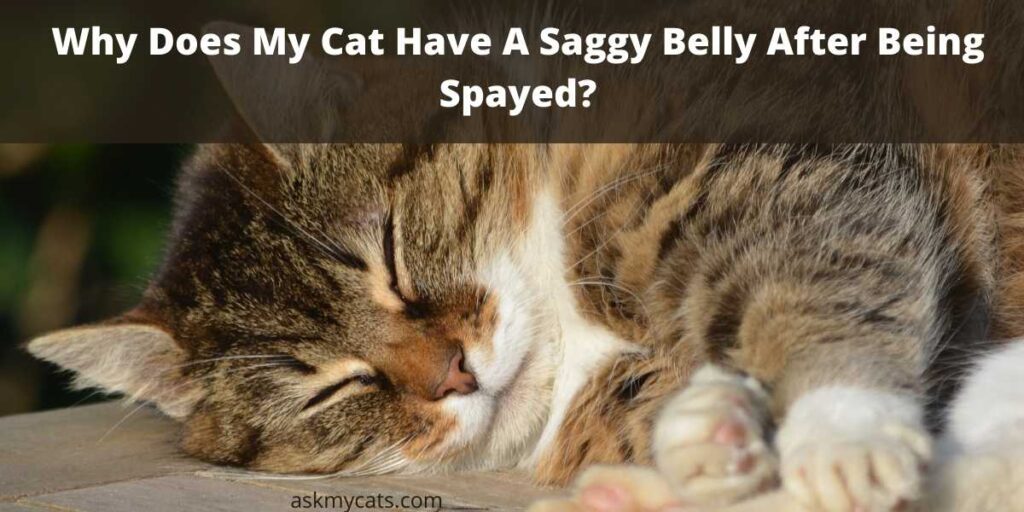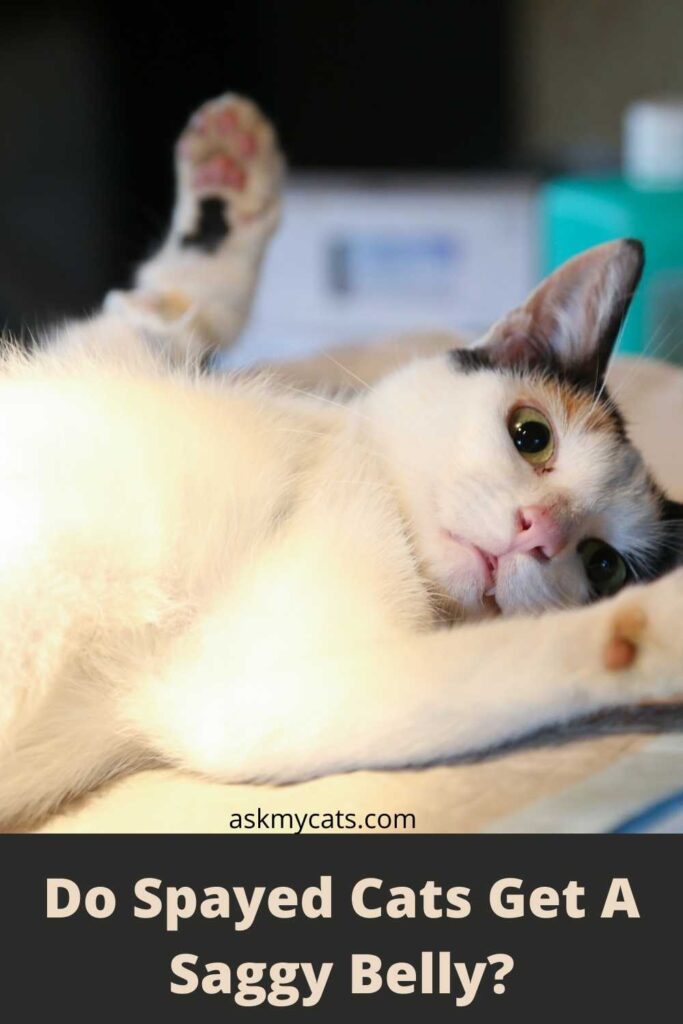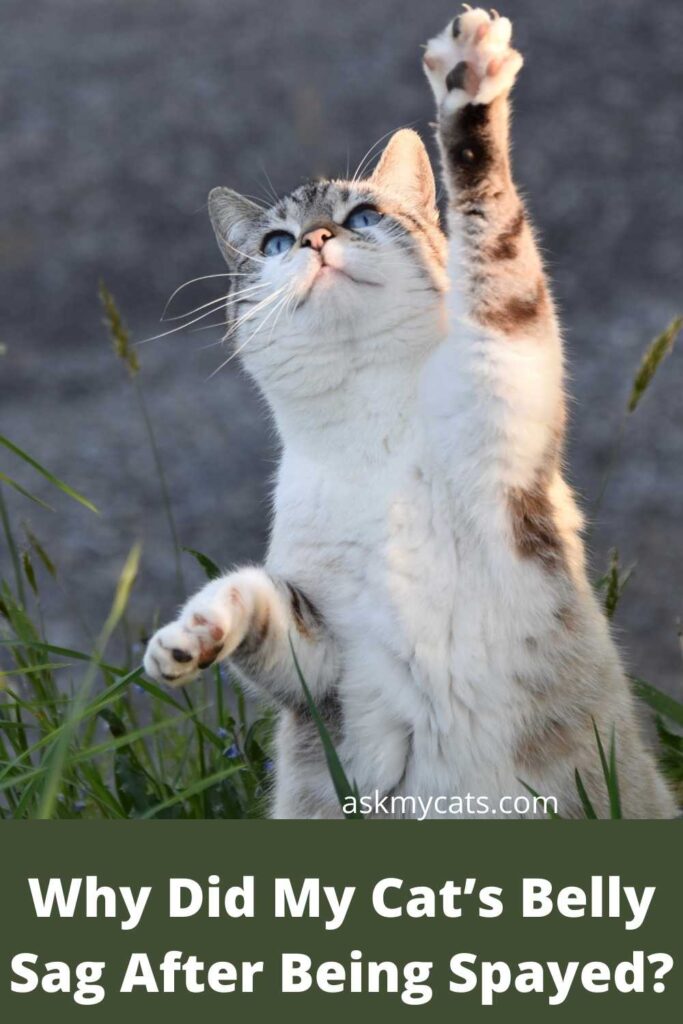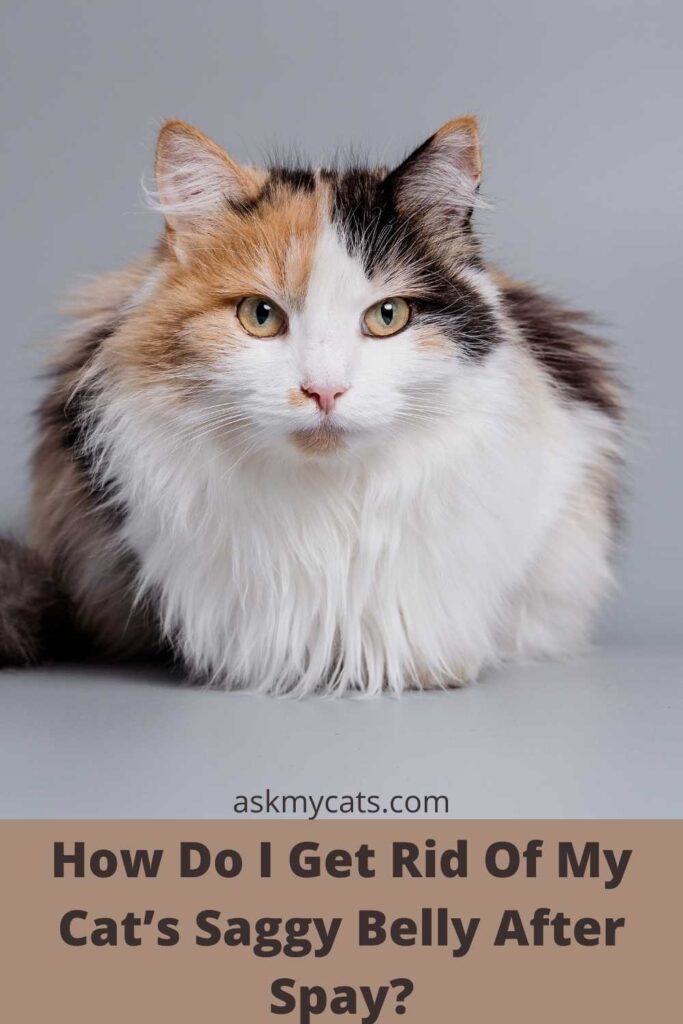Did you notice a pouch on your kitten’s side after he was spayed and wondered what it was?
The majority of cat owners are aware of their pet’s long whiskers, and many are aware that cats use them as sensors to explore their surroundings. But have you ever wondered if all cats had that hanging belly pouch?
In this article, you’ll find out what this saggy belly we are talking about is actually called and whether it is normal to have one or not.
You’ll also come across ways to get rid of it without much fuss.
Let’s get into it.


Give Your Cat the Perfect Day
Get the Free Ebook!
Do Spayed Cats Get A Saggy Belly?

Spaying has nothing to do with cats getting saggy bellies. When cats are spayed, their stomachs and, consequently, even their primordial pouches frequently appear to hang lower. Additionally, the skin flaps on them also seem to be longer.
Skin elasticity is mostly to blame for the sagging. These flaps are still present in cats who significantly reduce their weight, whether due to sickness or diet. The primordial pouch is healthy and shouldn’t cause alarm.
Many people think your cat’s pouch was created to allow the abdomen to expand as it consumes a substantial meal.
Although these are not the origins of the belly pouch, it is possible to detect more prominent sagging when a cat has been spayed (as it loses a substantial amount of weight).
If you own multiple cats, you may have noticed how they fight by kicking at each other’s bellies. That’s just for show, but the tactic is how they kill their prey.
Like most animals, cats have belly fat to shield their internal organs. All domestic cats have a loose skin flap that covers and protects their stomach (the primordial pouch).
Another reason why your cat might have a saggy belly:
Overweight
The primordial pouch has another useful function, which is to enable the stomach to grow and fill with food. This enables wild cats to have a substantial meal while the going is good.
This also enables domestic cats to eat a substantial meal while the going is good, but you should be feeding your cat frequently enough that he won’t need to stuff himself.
Interestingly, a veterinary survey conducted in 1997 by Cornell University revealed that roughly 25% of cats were overweight or obese.
Even though the study’s scope was somewhat constrained, it did highlight the dangers of cat obesity in terms of disease and even mortality.
Your cat’s primordial pouch might help you determine whether or not he is overweight. A good gauge can be seen from above. If you’re worried, talk to your veterinarian.
Interesting Read: Why Is My Cat Always Hungry After Being Spayed?
Why Did My Cat’s Belly Sag After Being Spayed?

Spaying may not necessarily be the reason for a cat getting a flabby belly.
The padding and loose skin around the belly offers additional protection for the abdominal region during bouts (also known as the “saggy belly”). Additionally, it shields and safeguards internal organs while enabling a cat to store extra food inside its tummy.
This additional flap of skin is present on all felines, regardless of their size, shape, or sex. These belly flaps are still present in cats who lose weight as a result of their diet or disease.
The pouch may grow larger as the cat ages, as its metabolism slows and it begins to retain more fat. In cats that were previously overweight and have been put on a diet to lose weight, the pouch may also seem to be more noticeable.
This is only the case because the pouch may have been effectively hidden from view by the total excess fat. The primordial pouch, in any case, is an organic component of a cat’s anatomy and has a range of functions, especially in the wild.
How To Know If Your Cat is Overweight?
- Healthy cats’ rib cage padding will feel similar in thickness to the back of your hand when you touch it. Your cat may be obese or overweight if you are unable to feel its ribs at all or if you can only do so when pressing strongly.
- To gain a sense of your cat’s weight and condition, we can also check for visual indicators. In the beginning, when your cat is standing, look down at them. The area above the hips should have a little depression that resembles a waist but keep in mind that if your cat has long hair, this may be challenging. Instead, if the waist area protrudes, your cat can be overweight.
Interesting Read: Why Is My Cat Not Eating After Spay?
How To Differentiate Between A Primordial Pouch And An Overweight Belly?
Pouch: When a cat approaches you trotting, you might notice a jiggling motion in the primordial pouch, which is a loose flap of skin.
If you gaze down at the cat, it will be challenging to see because it is on the underside of the belly.
Obesity: The belly of an obese cat is generally rounded and does not wiggle in the same way that the skin of a primordial pouch does.
If you run your hands along the cat’s sides and can’t feel the ribs, the cat is overweight and you should seek veterinary advice on how to assist the cat in losing weight.
Do Primordial Pouches Go Away On Their Own?
No, primordial pouches can never go away on their own because they are a part of their skin.
It is also not advised to attempt to remove it. What’s the necessity, exactly?
When under attack or pressure, the pouch shields the internal organs. When cats fight, you may have observed that they frequently kick each other with their hind legs and their pointed claws, which could potentially harm these delicate organs.
Cats may be able to stretch out when jumping or dashing quickly through the pouch. If a cat feeds on a big meal, the pouch might be used for further stomach enlargement.
Interesting Read: Why Do Cats Get A Lump After Being Spayed?
How Do I Get Rid Of My Cat’s Saggy Belly After Spay?

While a primordial pouch cannot be removed, you can take action if you see that your overweight cat has fat patches on his abdomen.
A cat that is overweight may have belly fat on the sides of the body, which won’t sway, but the primordial pouch is loose and situated on the underside of the abdomen.
Myth: Some pet owners wrongly think that a primordial pouch only appears in spayed cats.
This is entirely untrue; whether a cat is intact or not, you will always be able to notice its distinctive cat belly.
Technically, there’s nothing wrong with your cat’s having a “saggy belly”. It is literally a part of their skin.
How Can You Help Your Cat Lose Her Fat Pouch?
- Cats don’t require a lot of exercise to remain healthy, though the recommended quantity varies depending on the breed and age of the cat. In general, though, aim for two sessions of interactive play lasting fifteen minutes each every day. These sessions should include actions like chasing and leaping after a toy. To give your cat more opportunities to jump and climb, you might also think about buying an indoor cat tree.
- By giving your pet cat food with a nourishing weight control mix, you can aid in their progressive weight loss. Your veterinarian can suggest or even prescribe a specific therapeutic weight loss meal if your cat is extremely obese. Always introduce new cat foods gradually to help her become used to them.
- By taking your cat to the doctor for an examination, you can find out if they are overweight. The veterinarian can also offer a precise diagnosis and advice on how to manage your weight. Bring your cat to the veterinarian so it can weigh it frequently. This will inform the veterinarian whether any more dietary changes or testing are required.
Frequently Asked Questions
Is it normal for felines to have a big tummy?
Get your cat to a vet as soon as possible for an examination and a diagnosis if they have an enlarged abdomen, often known as ascites. Cats are excellent at concealing illness and will make every effort to do so. Being overweight, failure of internal organs, cancer, or parasites may be to blame for the ailment in question.
If your cat’s tummy has become larger over time, it can be because of weight issues. Your cat may wind up being overweight if it’s elderly, enjoys eating a lot, and isn’t active.
Numerous health problems that might reduce a cat’s life can arise from being overweight. Diabetes is more likely to develop in overweight cats. The extra weight could also cause bone fractures or joint problems for them. They will experience general fatigue and have problems getting out of beds or chairs.
Final Words
That’s it about cats and their primordial pouches (saggy bellies).
Let us know in the comments section if you ever had doubts regarding your cat’s fat flab under her tummy. How did you end up reaching this article for help?
